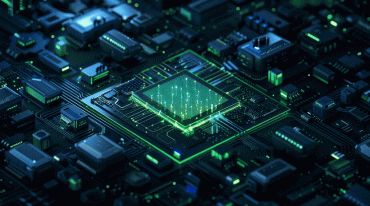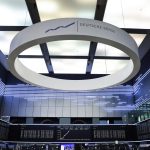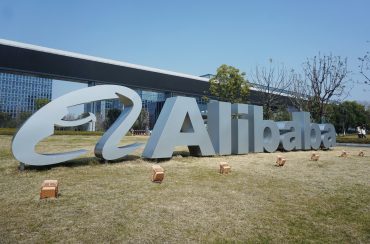

Major tech companies accelerate AI acquisitions as industry spending on cybersecurity solutions reaches record levels
Three Key Facts
- Global cybercrime costs reach $10.5 trillion* in 2025, driving unprecedented investment in cybersecurity products and services across the tech industry
- Semiconductor revenue grows double digits as demand for AI chips and data center infrastructure outpaces traditional automotive and industrial markets.
- Data creation hits 182 zettabytes** in 2025, prompting tech companies to prioritize data monetization and analytics platforms as core business strategies.
Introduction
The technology sector enters 2025 with artificial intelligence transforming from experimental tool to business imperative. Companies across the industry are restructuring operations around AI capabilities while navigating record cybersecurity threats and unprecedented data growth.
This transformation extends beyond product development into fundamental business model changes. Tech firms are adopting outcome-based pricing strategies and consolidating capabilities through strategic acquisitions to maintain competitive advantages in an increasingly AI-driven marketplace.
Key Developments
Major technology companies have accelerated merger and acquisition activity throughout 2025, with Salesforce, Google, IBM, Cisco, and Nvidia leading strategic purchases, while SAP has focused more on AI-centered partnerships than acquisitions. These acquisitions target AI capabilities, cybersecurity technologies, and advanced cloud infrastructure to strengthen market positions.
The shift toward AI-driven operations has moved beyond customer-facing applications into internal processes. Companies are implementing AI solutions for talent management, supply chain optimization, and unified customer engagement platforms that integrate sales, support, and success teams.
Data strategy has emerged as the new product strategy for tech firms. Organizations are developing platforms and tools designed to handle massive datasets, with companies focusing on data monetization, security, and utility as core revenue drivers.
Market Impact
The semiconductor industry leads market growth with double-digit revenue increases driven by generative AI chip demand. This surge outpaces traditional markets including automotive and industrial applications, reshaping industry revenue streams.
Tech stocks demonstrate resilience despite mixed economic signals, with companies showing strong performance amid Federal Reserve interest rate uncertainty. Energy stocks maintain stability as geopolitical tensions continue to influence market dynamics. These observations reflect general 2025 trends; energy sector resilience and Fed-driven volatility continue to shape investor sentiment but vary by region and market.
The cybersecurity sector experiences significant expansion as organizations increase security spending to combat escalating threats. This investment pattern supports sustained growth for security-focused technology providers.
Strategic Insights
The technology industry’s strategic focus has shifted from AI as a product feature to AI as operational infrastructure. Companies that successfully integrate AI into both customer products and internal operations are achieving measurable returns on investment while those lagging risk competitive disadvantage.
5G network rollouts are enabling new product categories including IoT devices, augmented reality applications, and autonomous systems. The technology delivers data rates up to 20 gigabits per second, supporting real-time processing and low-latency applications that create new revenue opportunities.
Sustainability and risk management have become integral to corporate strategy as geopolitical tensions and supply chain vulnerabilities influence operational decisions. Companies are investing in resilient supply chains and sustainable practices as long-term competitive requirements rather than optional initiatives.
Expert Opinions and Data
Industry analysts express optimism about the sector’s 2025 prospects while noting implementation challenges. Strong demand for AI, data analytics, and next-generation connectivity drives growth expectations, though talent shortages and complex integration requirements present operational hurdles.
The aggressive pace of merger and acquisition activity generates mixed reactions from stakeholders. While acquisitions enable rapid capability scaling, industry observers warn about potential impacts on competition, customer choice, and pricing structures across technology markets.
Cybersecurity experts emphasize the expanding attack surface created by IoT, cloud, and AI-powered systems. The projected $10.5 trillion* global cybercrime cost reflects both the scale of threats and the corresponding investment opportunities in security technologies.
Conclusion
The technology industry’s 2025 landscape reflects a fundamental shift toward AI-centric business models supported by strategic consolidation and data-driven operations. Companies are balancing growth opportunities in semiconductors, cybersecurity, and connectivity technologies against implementation challenges and evolving threat environments.
The sector’s current trajectory indicates sustained investment in AI capabilities, security infrastructure, and data analytics platforms will define competitive positioning. Organizations that successfully navigate these strategic priorities while managing operational complexity are positioning themselves for continued market leadership in an increasingly AI-driven economy.
* Note: This widely circulated figure comes from Cybersecurity Ventures’ long-term projection rather than a confirmed 2025 total. Other estimates, including FBI and IC3 data, suggest the actual financial impact may be significantly lower — closer to $1–1.5 trillion.)
** Recent estimates range between 175 and 182 zettabytes, depending on methodology; the figure reflects growing IoT, video, and enterprise data volumes.)








